Abstract
This study assessed the effects of irrigation with desalinated water on the growth of lettuce (Lactuca sativa L.). Two experiments, the first using saline and the second desalinated irrigation water, respectively, were designed to grow lettuce in plots (22 m × 0.4 m × 0.4 m) under controlled greenhouse conditions. Three levels of saline irrigation water and tap water (control) were used for the first experiment. In the second experiment, the three saline levels underwent a desalination process. Each experiment was carried out twice, in succession, with two replications. The results from the first experiment showed that the use of saline irrigation water caused an increase in the salinity level of soil and, consequently, adversely affected lettuce growth and yields. The results from the second experiment showed that the use of desalinated irrigation water does not negatively affect soil salinity and lettuce growth and yield. However, the need for additional application of the elements such as Ca2+ and Mg2+ was also identified since continued use of desalinated water irrigation correlated with a decrease in the sodium adsorption ratio (SAR), leading to increased risk of soil sodicity. This is due to the elimination of nutrients during the desalination process.
1. Introduction
Farmers increasingly consider desalinated water as a competitive source of irrigation water, particularly for high-value cash crops like greenhouse vegetables and flowers [1,2]. Due to enhanced desalination techniques and reduced costs [3,4,5], desalination has become a viable option for greenhouse cultivation. Desalinated water allows farmers to produce salt-sensitive and often more profitable crops [2], as well as provides quality irrigation water to greenhouse cultivation areas that suffer from freshwater scarcity but are rich in brackish water resources.
South Korea has about 93,551 ha devoted to greenhouse cultivation [6], most of which are located in the estuary and coastal area in order to easily supply irrigation water, mainly from groundwater extraction. Along with increased drought frequency [7], anthropogenic activities, including extensive groundwater extraction and upstream dam construction, have resulted in the salinization of both groundwater and estuarine surface water. Due to the use of saline water for irrigation, with the subsequent restriction in plant physiological activity [4,8,9], farmers have increasingly reported salt damages in greenhouse cultivation in recent years. Furthermore, salinization limits crop species within coastal greenhouse areas. However, desalination of brackish water could likely overcome salinity problems in coastal areas and produce quality irrigation water.
Although the desalination process reduces undesirable salts in saline water, ions including the essential nutrients required for crop growth like calcium (Ca2+), magnesium (Mg2+), and sulfate (SO42) can also be removed [5,8]. Irrigation with desalinated water that lacks essential nutrients can negatively affect crop productivity. As a matter of fact, Mg2+ deficiency symptoms were observed in crop productions (e.g., basil, tomatoes, and flowers) when farmers used desalinated water for irrigation in Israel, thus requiring additional fertilization [5]. In addition, the effects of irrigation with desalinated water on soil-water-plant relations can vary depending on the desalination system and the agricultural environment, which includes the quality of feed water, target crops, soil and weather conditions, and agricultural practices including irrigation methods. Therefore, before introducing a desalination system, it is necessary to evaluate its potential effects on a local agricultural environment. Many studies have been conducted to assess impacts of irrigation with seawater [10,11] as well as wastewater [12,13] or reclaimed water [14]. However, relatively few studies [1,4] have been undertaken to evaluate the impacts of irrigation with desalinated water on crop growth and soil properties.
In this study, we assessed the effects of desalinated water irrigation on lettuce (Lactuca sativa L.) cultivation within a greenhouse in South Korea. To do this, a newly developed small-scale brackish water desalination (BWD) system described in the following section was employed to produce desalinated irrigation water. Tap water (control) and three waters with different saline concentrations were used to irrigate eight experimental plots, resulting in four treatments and two replications for the experiment with saline irrigation water. Tap water as control and desalinated water from the three saline concentrations used in the former trial, processed through the desalination system, were utilized in the experiment with desalinated irrigation water. The chemical properties of soil and irrigation water, and the ways in which the lettuce crop responded to the treatment (i.e., leaf number, length, and width, shoot and plant weights, and sodium accumulation) were analyzed.
2. Materials and Methods
2.1. Experimental Design
The experiment was conducted in a greenhouse at the Pyeongchang Campus, Seoul National University, which is located in Gangwon-do, South Korea (37°32′51′′ N and 128°26′26′′ E). Eight experimental plots (22 m length × 0.4 m width × 0.4 m height) were designed for both saline and desalinated water irrigation experiments in a randomized complete block with four treatments and two replications. Plots were filled with commercial soil (Seoul Bio Inc, Chungcheongbuk-do, Korea). Characteristics of the soil were as follows: loam texture (49.6% sand, 33.8% silt, and 16.6% clay); pH measured in 1:5 soil:water suspension, 5.6; electrical conductivity of the saturated-soil extract (ECe), 8.5 dS m−1; cation exchange capacity (CEC), 73.2 cmol kg−1; total nitrogen (T-N), 0.596%; total phosphorus (T-P), 1676.0 mg kg−1; organic matter (OM), 65.5%; phosphorus pentoxide (P2O5), 1521.5 mg kg−1; calcium (Ca2+), 4534.8 mg kg−1; magnesium (Mg2+), 1935.5 mg kg−1; sodium (Na+), 1042.1 mg kg−1; and potassium (K+), 5478.8 mg kg−1 [15]. Drip irrigation was employed and one drip irrigation lateral was placed on the soil surface in the center of each plot. Irrigation water for each treatment was stored in 100 L plastic containers and was supplied using a metering pump (50 mL per minute) for each treatment. Lettuce (Lactuca sativa L.) is one of the most common vegetable crops grown in greenhouses from South Korea [6]. The lettuce cultivar used for both experiments was ‘Sunpungpochop’. One-month-old lettuce seedlings were transplanted in rows with 30 cm spacing along the drip lateral in each plot. The planting and harvest dates for each experiment are shown in Table 1. Daily temperature and relative humidity in the greenhouse were monitored during the experimental period.

Table 1.
Planting and harvesting dates, irrigation amounts and daily averages of temperature and relative humidity for each experimental phase.
To investigate the effects of irrigation with saline water on lettuce growth and yield, four different levels of saline water were prepared. Tap water was used as a control (BS#01). Saline irrigation water with three salinity levels was prepared by adding sodium chloride (NaCl) to tap water. The salinity levels of irrigation water (ECw) for the three treatments (BS#02, BS#03, and BS#04) were based on the salinity threshold for irrigation water given by Maas and Grattan [16]. The target ECw values were 0.9, 2.1, and 3.4 dS m−1 for BS#02, BS#03, and BS#04, respectively.
The small-scale brackish water desalination (BWD) system (Blue BS Inc., Suwon, Korea) with a capacity of 10 m3 day−1 was installed and operated in order to conduct the experiment with desalinated water (Figure 1). The BWD system consists of a micro-bubble generator, zeta potential floating tower, microfiltration (MF) membranes, reverse osmosis (RO) membranes, and several pumps. The feed water at three different salinity levels (0.9, 2.1, and 3.4 dS m−1) was prepared using the same procedure as described above and was then desalinated by using the BWD system. This desalinated water was subsequently used as irrigation water for the second experiment (AS#02, AS#03, and AS#04). Tap water was used as a control treatment (AS#01).
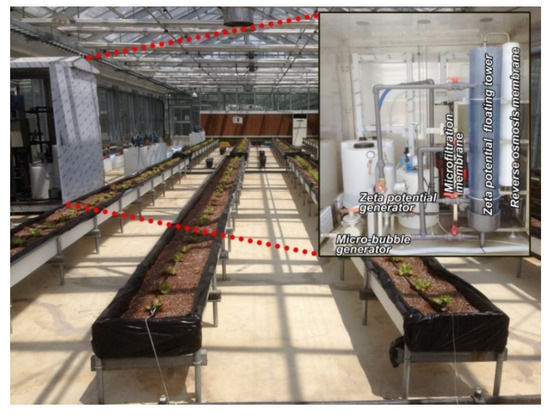
Figure 1.
Small-scale brackish water desalination (BWD) system installed in the experimental site and experimental plots planted with lettuce.
None of the applied water leached from the plots, and fertilizer was not applied to any of the treatments. In order to investigate the effects of continued irrigation with saline and desalinated water on crop yield and soil quality, the soil in each plot was not changed after completing the first phase of each experiment. After finishing the experiment with saline irrigation water, however, all plots were newly filled with commercial soil before starting the experiment with desalinated irrigation water.
2.2. Water Quality, Soil, and Plant Analyses
Water samples were collected twice during each lettuce-growing season and analyzed according to the standard methods of APHA [17] for pH, T-N, T-P, Ca2+, Mg2+, Na+, K+, chloride (Cl−), and sulfate (SO42−). The sodium adsorption ratio (SAR) was calculated from the analyzed concentrations of Ca2+, Mg2+, and Na+. ECw was measured weekly using an EC meter (Hanna Instruments Inc., HI98192) and determined twice in the laboratory during each lettuce-growing season.
At the end of each experiment, five soil samples from each treatment were collected and then mixed to produce one representative soil sample. Chemical analyses were conducted according to the soil analysis methods of the American Society of Agronomy (ASA) and the Soil Science Society of America (SSSA) [18]. The soil properties determined included pH, electrical conductivity of the saturated-soil extract (ECe), CEC, T-N, T-P, P2O5, OM, and exchangeable cations including Ca2+, Mg2+, Na+, and K+.
At the end of each experiment, the number of leaves, leaf length, maximum leaf width, and fresh weight were measured for twenty different plants that were randomly sampled from each treatment (10 samples from each replicate). To determine the accumulation of Na+ in the leaves, the sampled lettuces were first washed with distilled water in the laboratory to remove soil particles and then oven-dried at 60 °C. Afterward, 0.5 g of the lettuce tissue was dissolved in 10 mL HNO3. The digested solution was filtered into a 25.0 mL volumetric flask through a Whatman No. 40, 125 mm filter paper. In the solution, the Na+ content was measured using inductively coupled plasma optical emission spectrometry (ICP–OES; iCAP 7000, Thermo Fisher Scientific Inc., Waltham, MA, USA).
2.3. Statistical Analysis
One-way analysis of variance (ANOVA) was used to determine the effect of the different treatments on lettuce. Tukey’s honest significant difference (HSD) test was used to detect significant differences between means at p < 0.05. All statistical analyses were conducted using SPSS 21.0 (SPSS Inc, Chicago, IL, USA).
3. Results and Discussion
3.1. Irrigation Water
During the saline irrigation experiment, the average ECw of the irrigation water was about 0.28, 0.88, 2.05, and 3.28 dS m−1 for BS#01, BS#02, BS#03, and BS#04 treatments, respectively (Table 2). As the salinity level increased, the concentrations of both Na+ and Cl− also increased.

Table 2.
Properties of saline and desalinated irrigation water for each treatment and experimental cycle.
The average SAR value of each treatment was 0.42, 5.30, 15.08, and 25.65 for BS#01, BS#02, BS#03, and BS#04, respectively (Table 2). Sodicity impairs the physical properties of soil, resulting in the deterioration of aggregate stability, decreased soil conductivity, and soil compaction. This makes plant growth difficult and, ultimately, affects crop yields [19]. Ayers and Wescot [20] used SAR and ECw to evaluate the sodicity hazards of irrigation water on soil permeability. According to their criteria, all treatments in the first experiment of the current study fell into the “Slight to Moderate” category (Figure 2).
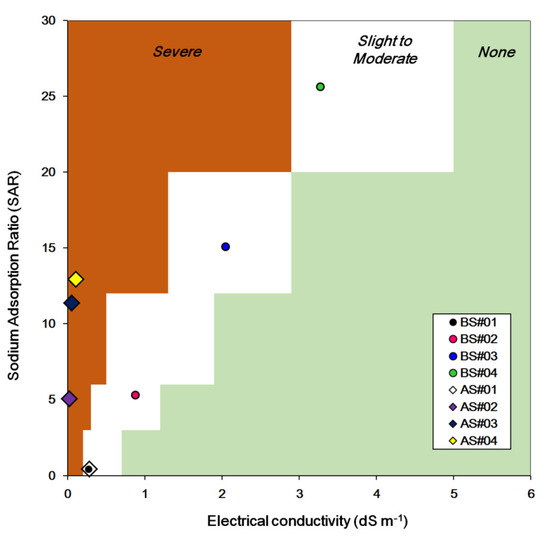
Figure 2.
Soil sodicity potential risk, evaluated using the sodium adsorption ratio (SAR) and the electric conductivity (ECw) of irrigation water. BS: before water treatment using the BWD system, i.e., saline water irrigation; AS: after water treatment using the BWD system, i.e., desalinated water irrigation.
The BWD system dramatically reduced the ECw of the feed water. While the system was operating, the average ECw of the desalinated irrigation water, effluent from the BWD system, was 0.02, 0.06, and 0.11 dS m−1 for AS#02, AS#03, and AS#04 treatments, respectively (Table 2), which were even lower than that of the control treatment AS#01 (0.28 dS m−1). Moreover, the concentrations of phytotoxic elements (Na+ and Cl−) in the desalinated irrigation water were also significantly lower than those of the saline irrigation water used in BS#02, BS#03, and BS#04.
In terms of SAR values, levels within AS#03 (11.39) and AS#04 (12.95) were severely reduced, whereas AS#01 (0.43) and AS#02 (5.07) maintained values similar to those of the saline irrigation water (Table 2). The drastic reduction in the ECw and the relatively small decrease in SAR, due to decreasing Na+, Ca2+, and Mg2+ concentrations caused by the use of the BWD system, increased the risk of soil sodicity. Except for the case of AS#01, which showed a “Slight to Moderate” level of soil sodicity risk, the other treatments showed “Severe” levels of soil sodicity risk (Figure 2). Blending water from different sources must be needed for reducing or mitigating soil sodicity risks [19,21].
Despite the application of the BWD system, Na+ and Cl- concentrations in AS#04 were higher than those in AS#01 (Table 2). The treatment efficiency of the BWD system in reducing Na+ and Cl- concentrations, however, showed a similar range for the three treatments, about 97–98%. The efficiency level lowered slightly as the concentration of both elements in the feed water increased. Moreover, the application of the BWD system not only separated unwanted dissolved salts from the feed water but also caused a reduction in the concentration of all other solutes including essential nutrients (Table 2). In particular, the BWD system removed almost all of the Ca2+, Mg2+, and SO42− in the feed water, demonstrating a treatment efficiency of more than 99% in this respect. The system also showed a relatively high treatment efficiency (more than 80%) in terms of filtering out T-N and K+. Desalinated irrigation water in this study showed lower concentrations of essential nutrients as compared with previous studies [1,19]. This is probably because of the more elaborate treatment process of the BWD system that resulted in cleaner feed water quality.
3.2. Soil
Soil properties were directly affected by irrigation water quality. Saline water increased the salinity level of the soil, especially in the cases of BS#03 and BS#04 which were irrigated with a salinity level above the lettuce’s threshold (0.9 dS m−1) (Table 3). The final ECe values of BS#03 and BS#04 were 30.8 and 34.8 dS m−1, respectively. Moreover, SAR and N+ concentrations in soil showed similar results. The concentrations of ECe, SAR, and Na+ increased over time in both BS#03 and BS#04. However, there were no remarkable changes in the experiments with desalinated irrigation water (Table 3). ECe, SAR, and Na+ concentrations in the first phase of the experiment were higher than those in the second phase, except for AS#04 where irrigation water with the highest level of Na+ concentration was used.

Table 3.
Chemical properties of the sampled soils from each experiment.
3.3. Lettuce Growth
The increased salinity level of irrigation water significantly affected the length and width of leaves among the various treatments (p < 0.05) (Figure 3). In both the first and second phases of the experiment, the lowest values of leaf length and width were observed in BS#04. The effect of saline water irrigation on lettuce growth increased with time, as significant differences in leaf length and width were identified in BS#03 during the second phase of the experiment (Figure 3). However, the number of leaves was less affected by saline irrigation water, presumably because the level of salinity, which affects the number of lettuce leaves, is higher than the salinity level that affects leaf length and width. Similarly, Andriolo et al. [22] reported that the number of lettuce (cv. Vera) leaves was not affected by salinity treatments ranging between 0.80 and 4.72 dS m−1. As shown in Figure 4, there were no significant differences in the number, length, and width of leaves among the treatments (p > 0.05) that used desalinated irrigation water. This result suggests that the use of desalinated water does not negatively affect lettuce growth.
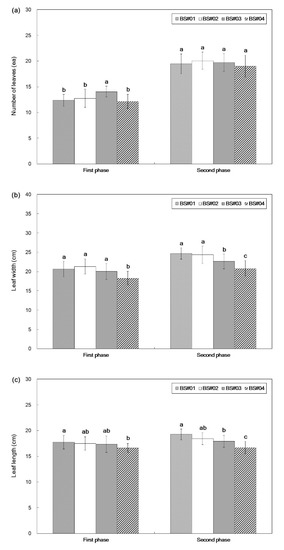
Figure 3.
Effect of saline irrigation water on (a) number of leaves, (b) leaf width, and (c) leaf length. Bars represent the mean ± standard deviation, n = 20. Different letters indicate significant differences among treatments by Tukey’s honest significant difference test at p < 0.05. BS: before water treatment using the BWD system, i.e., saline water irrigation.
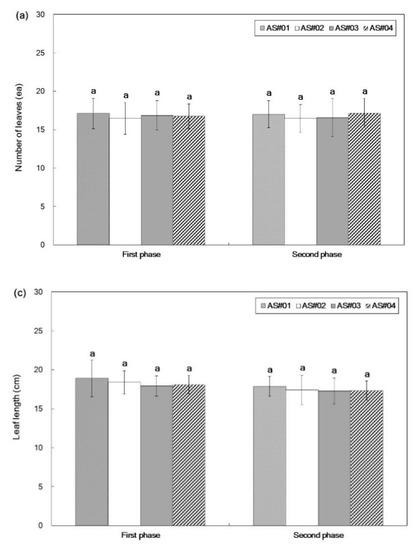
Figure 4.
Effect of desalinated irrigation water on (a) number of leaves, (b) leaf width, and (c) leaf length. Bars represent the mean ± standard deviation, n = 20. Different letters indicate significant differences among treatments by Tukey’s honest significant difference test at p < 0.05. AS: after water treatment using the BWD system, i.e., desalinated water irrigation.
3.4. Lettuce Yield
In the experiment with saline irrigation water, significant differences (p < 0.05) in total and shoot fresh weights of lettuce were observed after both the first and second phases of the experiment (Figure 5). In the first phase, there were no significant differences in total and shoot fresh weights between the control and the two treatments with less saline water, i.e., BS#02 and BS#03, and between the control and the treatment #04. In the second phase, however, both fresh weights significantly decreased in the treatment BS#04 with the salinity level above 3.4 dS m−1. This result indicates that the yield of lettuce is affected by continued use of saline irrigation water and that the threshold salinity level for lettuce yield could be about 3.4 dS m−1. Turhan et al. [11] reported that there were no significant differences in fresh and marketable lettuce (cv. Funly) yield at low irrigation water salinity (1.2 and 2.1 dS m−1), whereas the significant decrease was observed above 3.7 dS m−1. The reduction of lettuce yields might be attributed to disturbances in physiological and biochemical activities including water and mineral uptake [15,22]. Ünlükara et al. [23] reported that the average of lettuce (Lactuca sativa var. crispa) fresh weights ranged from 74.6 to 144.8 g with irrigation salinity levels ranging from 0.75 to 3.5 dS m−1 in the greenhouse. In this study, the average of fresh weights ranged from 81.0 to 219.2 g with irrigation salinity levels ranging from 0.9 to 3.4 dS m−1 (Figure 5).
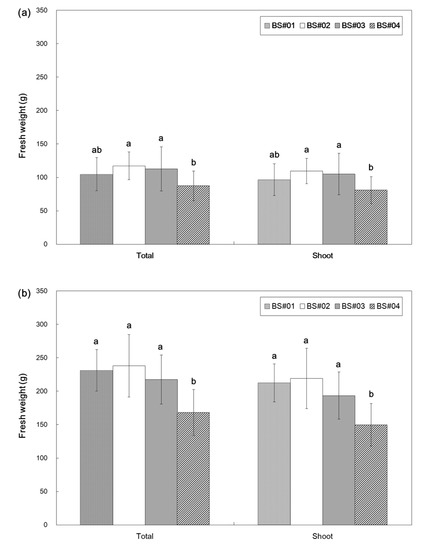
Figure 5.
Effect of saline irrigation water on lettuce shoot and total fresh weights after the (a) first and (b) second phases of the experiment. Bars represent the mean ± standard deviation, n = 20. Different letters indicate significant differences among treatments by Tukey’s honest significant difference test at p < 0.05. BS: before water treatment using the BWD system, i.e., saline water irrigation.
In the experiment with desalinated water, no significant differences in total and shoot fresh weights of lettuce were detected among the treatments (p > 0.05) (Figure 6). This result indicates that irrigation with desalinated water did not negatively affect lettuce yield under the conditions of the current study.
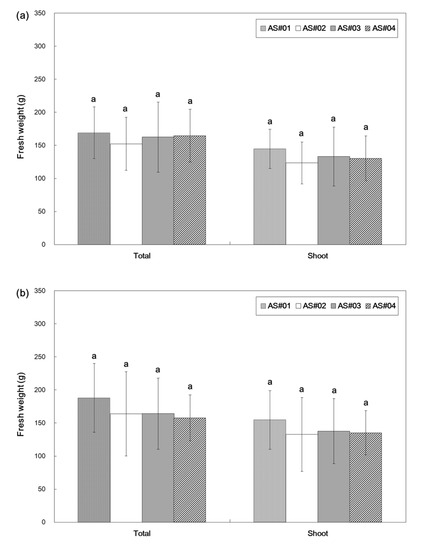
Figure 6.
Effect of desalinated irrigation water on lettuce shoot and total fresh weights after the (a) first and (b) second phases of the experiment. Bars represent the mean ± standard deviation, n = 20. Different letters indicate significant differences among treatments by Tukey’s honest significant difference test at p < 0.05. AS: after water treatment using the BWD system, i.e., desalinated water irrigation.
3.5. Sodium Accumulation in Lettuce Leaves
The concentration of Na+ in the lettuce leaves increased with the salinity level of irrigation water in the first experiment Figure 7a; the highest concentration was found in BS#04, whereas the lowest value was observed in BS#01. Significant differences among treatments were found after both the first and second phases of the experiment (p < 0.05). For all treatments, the Na+ concentration during the second phase of the experiment increased as compared with the concentration levels after the first phase. The greatest difference in the Na+ concentration was observed in BS#04 (3185.2 mg kg−1), followed by BS#03 (2720.5 mg kg−1), BS#02 (1996.3 mg kg−1), and BS#01 (1270.3 mg kg−1). These results show that the use of saline water increases the concentration of Na+ in the lettuce leaves and that the continued use of saline water may cause increased Na+ accumulation in lettuce leaves.
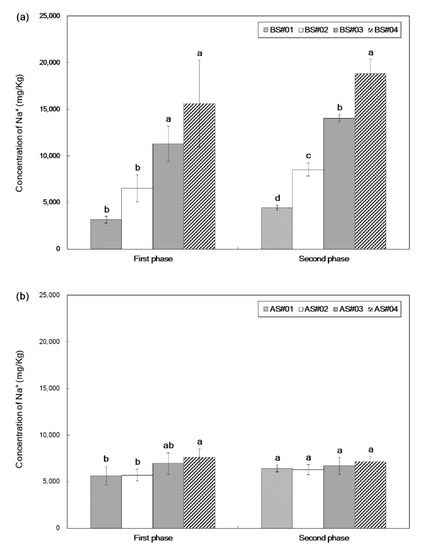
Figure 7.
Effect of (a) saline and (b) desalinated irrigation water on Na+ concentration in the leaves. Bars represent the mean ± standard deviation, n = 5. Different letters indicate significant differences among treatments by Tukey’s honest significant difference test at p < 0.05. BS: before water treatment using the BWD system, i.e., saline water irrigation; AS: after water treatment using the BWD system, i.e., desalinated water irrigation.
In the case of the experiment with desalinated irrigation water, a significant difference in the concentration of Na+ in the lettuce leaves was observed between treatments during the first phase of the experiment, whereas no significant differences were detected during the second phase Figure 7b. As shown in Figure 7, differences between the Na+ accumulation levels within the desalinated irrigation treatments were remarkably less than those present within the saline irrigation water treatments. This indicates that the use of the desalination system can help prevent Na+ accumulation in lettuce leaves.
4. Conclusions
In the current study, the use of saline water for greenhouse irrigation increased the salinity level of soil and in turn decreases lettuce yields. In contrast, the application of desalinated irrigation water did not negatively affect crop growth, crop yield, or soil salinity. In addition, the results from the experiment with desalinated irrigation water seemed to indicate that the additional application of essential nutrients (e.g., Ca2+ and Mg2+) is recommended in order to reduce the soil sodicity risk as well as to compensate for the removal of essential nutrients by the desalination system. The response of crops treated with desalinated irrigation water may change due to environmental factors such as soil composition, weather conditions, agricultural practices including irrigation methods and the use of fertilizers, as well as the quality of desalinated water. Nevertheless, the present study suggests that irrigation with desalinated water could reduce the pressure on water resources without drastically compromising crop yields and soil quality.
Author Contributions
H.K. and H.J. designed the experiment, performed the experimental work and statistical analysis, produced the tables, and wrote the paper. J.J. and S.K. performed the experimental work, data collection, and chemical analyses. H.K., H.J., S.K., and J.J. all read and made improvements to the manuscript. All authors have read and agreed to the published version of the manuscript.
Funding
This work was supported by Research Resettlement Fund for the new faculty of Seoul National University and Korea Institute of Planning and Evaluation for Technology in Food, Agriculture, Forestry and Fisheries (IPET) through the Agri-Bio industry Technology Development Program, funded by the Ministry of Agriculture, Food and Rural Affairs (MAFRA) (grant number 114060-3).
Conflicts of Interest
The authors declare no conflicts of interest.
References
- Ben-Gal, A.; Yermiyahu, U.; Cohen, S. Fertilization and blending alternatives for irrigation with desalinated water. J. Environ. Qual. 2009, 38, 529–536. [Google Scholar] [CrossRef] [PubMed]
- Birnhack, L.; Shlesinger, N.; Lahav, O. A cost effective method for improving the quality of inland desalinated brackish water destined for agricultural irrigation. Desalination 2010, 262, 152–160. [Google Scholar] [CrossRef]
- Barron, O.; Ali, R.; Hodgson, G.; Smith, D.; Qureshi, E.; McFarlane, D.; Campos, E.; Zarzo, D. Feasibility assessment of desalination application in Australian traditional agriculture. Desalination 2015, 364, 33–45. [Google Scholar] [CrossRef]
- Silber, A.; Israeli, Y.; Elingold, I.; Levi, M.; Levkovitch, I.; Russo, D.; Assouline, S. Irrigation with desalinated water: A step toward increasing water saving and crop yields. Water Resour. Res. 2015, 51, 450–464. [Google Scholar] [CrossRef]
- Yermiyahu, U.; Tal, A.; Ben-Gal, A.; Bar-Tal, A.; Tarchitzky, J.; Lahav, O. Rethinking desalinated water quality and agriculture. Science 2007, 318, 920–921. [Google Scholar] [CrossRef] [PubMed]
- Ministry of Agriculture, Food and Rural Affairs (MAFRA). Agriculture, Food, and Rural Affairs Statistics Yearbook; Ministry of Agriculture, Food and Rural Affairs: Sejong, Korea, 2015.
- Nam, W.H.; Hayes, M.J.; Svoboda, M.D.; Tadesse, T. Drought hazard assessment in the context of climate change for South Korea. Agric. Water Manag. 2015, 160, 106–117. [Google Scholar] [CrossRef]
- Ghermandi, A.; Messalem, R. The advantages of NF desalination of brackish water for sustainable irrigation: The case of the Araba Valley in Israel. Desalin. Water Treat. 2009, 10, 101–107. [Google Scholar] [CrossRef]
- Plaut, Z.; Edelstein, M.; Ben-Hur, M. Overcoming salinity barriers to crop production using traditional methods. Crit. Rev. Plant Sci. 2015, 32, 250–291. [Google Scholar] [CrossRef]
- Atzori, G.; Mancuso, S.; Masi, E. Seawater potential use in soilless culture: A review. Sci. Hortic. 2019, 249, 199–207. [Google Scholar] [CrossRef]
- Turhan, A.; Kuscu, H.; Ozmen, N.; Serbeci, M.S.; Demir, A.O. Effect of different concentrations of diluted seawater on yield and quality of lettuce. Chilean J. Agric. Res. 2014, 74, 111–116. [Google Scholar] [CrossRef]
- Urbano, V.R.; Mendonça, T.G.; Bastos, R.G.; Souza, C.F. Effects of treated wastewater irrigation on soil properties and lettuce yield. Agric. Water Manag. 2017, 181, 108–115. [Google Scholar] [CrossRef]
- Carvalho, R.S.C.; Bastos, R.G.; Souza, C.F. Influence of the use of wastewater on nutrient absorption and production of lettuce grown in a hydroponic system. Agric. Water Manag. 2018, 203, 311–321. [Google Scholar] [CrossRef]
- Maestre-Valero, J.F.; Gonzalez-Ortega, M.J.; Martínez-Álvarez, V.; Gallego-Lira, B.; Conesa-Jodar, F.J.; Martin-Gorriz, B. Revaluing the nutrition potential of reclaimed water for irrigation in southeastern Spain. Agric. Water Manag. 2019, 218, 174–181. [Google Scholar] [CrossRef]
- Kim, H.K.; Jeong, H.; Jeon, J.; Bae, S. Effects of irrigation with saline water on crop growth and yield in greenhouse cultivation. Water 2016, 8, 127. [Google Scholar] [CrossRef]
- Mass, E.V.; Grattan, S.R. Crop yields as affected by salinity. In Agricultural Drainage, Agronomy Monograph 38; Skaggs, R.W., Van Schilfgaarde, J., Eds.; American Society of Agronomy, Crop Science Society of America, Soil Science Society of America: Madison, WI, USA, 1999; pp. 55–108. [Google Scholar]
- American Public Health Association (APHA). Standard Methods for the Examination of Water and Wastewater, 19th ed.; American Public Health Association: Washington, DC, USA, 1995. [Google Scholar]
- Chapman, H.D.; Pratt, P.F. Methods of Analysis for Soils, Plants and Waters; University California, Berkeley: Berkeley, CA, USA, 1961. [Google Scholar]
- Martínez-Alvarez, V.; González-Ortega, M.J.; Martin-Gorriz, B.; Soto-García, M.; Maestre-Valero, J.F. The use of desalinated seawater for crop irrigation in the Segura River Basin (south-eastern Spain). Desalination 2017, 422, 153–164. [Google Scholar] [CrossRef]
- Ayers, R.S.; Westcot, D.W. Water Quality for Agriculture, FAO Irrigation and Drainage Paper 29; Food and Agriculture Organization of the United Nations: Rome, Italy, 1985; Available online: http://www.fao.org/docrep/003/t0234e/t0234e00.htm (accessed on 10 June 2019).
- Martínez-Alvarez, V.; Martin-Gorriz, B.; Soto-García, M. Seawater desalination for crop irrigation—A review of current experiences and revealed key issues. Desalination 2016, 381, 58–70. [Google Scholar] [CrossRef]
- Andriolo, J.L.; da Luz, G.L.; Witter, M.H.; Godori, R.S.; Barros, G.T.; Bortolotto, O.C. Growth and yield of lettuce plants under salinity. Hort. Brazil. 2005, 23, 931–934. [Google Scholar] [CrossRef]
- Ünlükara, A.; Cemek, B.; Karaman, S.; Erşahin, S. Response of lettuce (Lactuca sativa var. crispa) to salinity of irrigation water. N. Z. J. Crop Hortic. Sci. 2008, 36, 265–273. [Google Scholar] [CrossRef]
© 2020 by the authors. Licensee MDPI, Basel, Switzerland. This article is an open access article distributed under the terms and conditions of the Creative Commons Attribution (CC BY) license (http://creativecommons.org/licenses/by/4.0/).